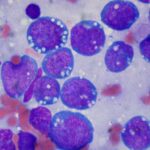
Malignant oral lesions are considered rare in childhood although their incidence is thought to be increasing. Malignant oral lesions in children an adolescents being predominantly embryonic and affecting the cells of the blood system and supporting tissues.
The aim of this review was to assess the prevalence, types and distribution of malignant oral lesions in children and adolescents.
Methods
Searches were conducted in the EBSCO, Embase, LILACS, LIVIVO, Medline/PubMed, Scopus, Web of Science, Google Scholar, OpenGrey, and ProQuest Dissertations and Theses databases. Studies reporting the frequency or prevalence of malignant oral lesions in children and adolescents were considered. Two reviewers independently searched and selected studies. One review extracted data which was cross-checked by a second reviewer. Risk of bias was assessed by two reviewers independently using the Newcastle-Ottawa scale (NOS) modified for cross-sectional studies and meta-analysis conducted.
Results
- 43 studies were included.
- Studies were conducted in Argentina (3), Australia (1), Brazil (13), Chile (1), Greece (2), India (2), Iran (2), Iraq (1), Israel (1), Nigeria (2), Saudi Arabia (1), South Africa (1), Taiwan (3). Thailand (3), Turkey (1), UK (1), USA (4), and Uruguay (1).
- One study was considered to be at low risk of bias, 2 at high risk and the remaining 40 at moderate risk.
- Meta-analysis showed an overall prevalence of malignant lesions = 1.93% (95%CI; 1.21 to 2.80%) [42 studies, 64,522 paediatric biopsies].
- More malignant lesions were seen in boys than girls ratio = 1.391 [23 studies].
- Unspecified lymphomas followed were the most prevalent lesions (see table).
- The overall certainty of the evidence was assessed a very low using the GRADE process.
| Lesion | Prevalence (95%CI) |
| Unspecified lymphoma | 12.08% (5.732% to 20.386%) |
| Rhabdomyosarcoma | 10.53% (7.277% to 14.299%) |
| Soft tissue sarcoma | 8.83% (5.837% to 12.373%) |
| Burkitt lymphoma | 8.24% (3.156% to 15.445%) |
| Squamous cell carcinoma | 7.84% (4.726% to 11.655%) |
| Osteosarcoma | 7.33% (4.325% to 11.052%) |
| Mucoepidermoid carcinoma | 7.16% (4.290% to 10.696%) |
| Langerhans cell histiocytosis | 5.84% (4.290% to 10.696%) |
| Non- Hodgkin’s lymphoma | 4.47% (1.323% to 9.288%) |
| Hodgkin’s lymphoma | 4.02% 1.464% to 7.784%) |
Conclusions
The authors concluded: –
…….oral malignant lesions from biopsies in children and adolescents had a prevalence of <3%, and lymphomas and sarcomas were the most common lesions.
Comments
The authors preregistered their review protocol on PROSPERO and undertook a search of a broad range of databases. A majority of the studies (18/43) were from south America with 13 of these coming from Brazil. All of the included studies were retrospective using a range of data collection periods. Only one being considered to be at low risk of bias, 40 being considered to be a moderate risk of bias and two at high risk. The estimated overall prevalence was 1.93% (95%CI; 1.21 to 2.80%) with a higher prevalence of 18.51% (95%CI; 3.844% to 40.721%) seen the African studies, however, this data is from 3 small studies. Future well conducted and reported prospective studies using recognised guidelines like STROBE would be helpful the improve the estimate of prevalence and identify any future changes.
Links
Primary Paper
de Paula DS, Nóbrega Malta CE, de Brito WH, Lemos JVM, Cetira Fillho EL, Costa FWG, Alves APNN, de Barros Silva PG. Prevalence of malignant neoplastic oral lesions among children and adolescents: a systematic review and meta-analysis. Int J Paediatr Dent. 2020 Dec 1. doi: 10.1111/ipd.12765. Epub ahead of print. PMID: 33289182.
Picture Credits
By Ed Uthman, MD., CC BY 2.0, Link
